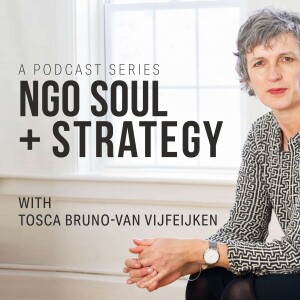
074. Can Nonprofit Program Evaluation Truly Be Made Easy? Chari Smith
 2024-04-19
2024-04-19
Summary
Quite a few smaller size social sector organizations assume that program evaluation is too complex or demanding an undertaking for them. Is that the case, though?
If we want to introduce program evaluation to staff, leadership, and boards who have not yet been inducted into the importance of program evaluation: what are the most effective questions to generate genuine interest in and motivation to engage in such program evaluation?
How can we build a more evaluation-friendly culture all around?
Chari Smith, President and Founder of the consulting company Evaluation into Action has written a book that gives clear answers to these questions: Nonprofit Program Evaluation Made Simple (2021). She explains her core argument in this podcast episode.
Chari's Bio:
- Program Evaluation enthusiast: Author, Speaker, Consultant, and Trainer
- President/Founder of Evaluation into Action, a consulting company
- Program Evaluation Associate at Northwest Regional Educational Laboratory
We discuss:
- Chari’s book is meant for small to midsize nonprofits who have not yet taken up program evaluation, to make it achievable to them. The book is also meant for entry-stage evaluators
- Chari values Beth Kanter's and Aliza Sherman’s definition of organizational culture – “Organizational culture is a complex tapestry made up of attitudes, values, behaviors, and artifacts of the people who work for your nonprofit.”
- If you apply a collaborative, inclusive, participatory, and non-siloed approach to introducing program evaluation, your chances of increasing buy-in grow considerably
- Only collect data that you will actually analyze and synthesize into actionable data and that is likely to influence decision-making
- A program evaluation-friendly culture cannot be ‘mandated’, on the one hand
- On the other hand, the role of culture ambassadors – people who already are in favor of program evaluation – is important in instilling an evaluation-friendly culture
- What's also important is the role of organizational ‘heroes’, and the use of stories, images, and narratives, while organizational artifacts (tangible objects that can be seen around the organization) can be used to signal a desired culture.
Quote:
- “By gathering data, nonprofits can pivot from a reactive stance to a proactive one, by acting on the data gathered”
Resources:
- Chari’s LinkedIn Profile
- Website of ‘Evaluation into Action’
- Book ‘Nonprofit Program Evaluation Made Simple’
More Episodes
Create your
podcast in
minutes
- Full-featured podcast site
- Unlimited storage and bandwidth
- Comprehensive podcast stats
- Distribute to Apple Podcasts, Spotify, and more
- Make money with your podcast
It is Free
- Privacy Policy
- Cookie Policy
- Terms of Use
- Consent Preferences
- Copyright © 2015-2024 Podbean.com





